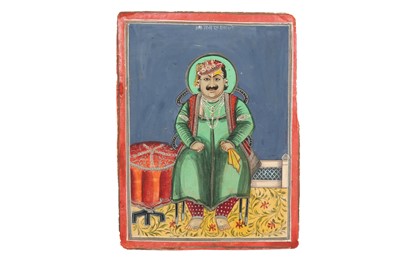16th Jul, 2021 12:00
Islamic & Indian Paintings: The Dexter Collection Part II
FOUR SEATED PORTRAITS OF INDIAN RULERS AND NOBLEMEN
Jaipur, Jodhpur and Delhi, Northern India, late 19th and 20th century
FOUR SEATED PORTRAITS OF INDIAN RULERS AND NOBLEMEN
Jaipur, Jodhpur and Delhi, Northern India, late 19th and 20th century
Opaque pigments, ink and pencil on paper and cardboard, comprising a full seated portrait of Thakur Laxman Singhji (d. 1930) of Sardargarh, signed by the artists Nandram Manawat from Devgarh and dated 1899 on the lower right corner, the composition replicating the popular indoor studio style typical of 19th-century black and white photographs providing a classic example of the new photo-realistic language of Indian paintings in the late 19th and 20th centuries, the recto marked with property stamps, 35.5cm x 26.5cm; and three other indoor seated portraits, of different sizes, with different subjects, one possibly of Raja Chandu Lal (1766 - 1845), the Prime Minister of the Nizams of Hyderabad, the largest 37.7cm x 28cm.
The reverse of the portrait of Thakur Laxman Singhji presents three property stamps, of respectively Bhanwar Devendra Singh, Bh. Suraya Vijay Singh Shekhawat and Kumar Sangram Singh (B.P. 128), all of Nawalgarh. These are all renowned Indian art collectors and connoisseurs. A standing portrait of Rao Raja Bhim Singh of Uniara, sold at Christie's London, 12 June 2018, lot 13, and another painting in the Dexter collection, a portrait of Prince Bhupal Singh and his teachers, sold in these Rooms, 16 April 2021, lot 359, presented the exact same property stamps of the three above-mentioned Nawalgarh collectors.
The portrait is also identical to another portrait of Thakur Laxman Singhji of Sardargarh in the Anil Relia's collection (http://www.theindianportrait.com/artwork/thakur-laxman-singhji-of-sardargarh/). Both paintings are signed by the same artist and hand, and share the same date. Rather than a later replica, it is plausible to believe that our painting is a contemporary production by Nandram Manwat, who would have probably been commissioned with the production of more than one painting for this ruler. Very often, these official portraits would have been gifted to members of the court and diplomatic envoys. Their wide circulation was deemed a fundamental form of propaganda boosting the image and favour of the ruler.
Sold for £500
Includes Buyer's Premium
Do you have an item similar to the item above? If so please click the link below to submit a free online valuation request through our website.



